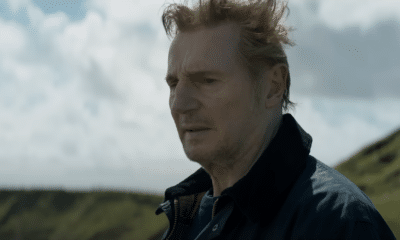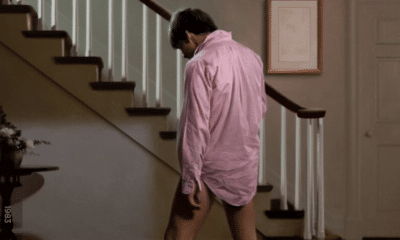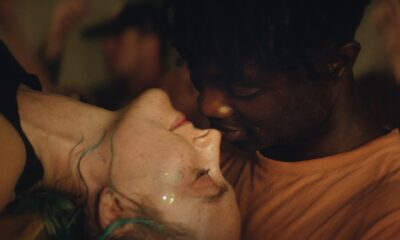Throughout the year, THN will look at 53 Walt Disney Animated Classics, from SNOW WHITE to WRECK-IT RALPH, through the obscurity of FUN AND FANCY FREE to the second Golden Age of BEAUTY AND THE BEAST. These are the films the Walt Disney company are most proud of, the ones that hold a special place in our hearts, the ones that still cost a fortune to buy on DVD.
This week it’s ONE HUNDRED AND ONE DALMATIANS.
Directed by Clyde Geronimi, Hamilton Luske and Wolfgang Reitherman
1961/ 79 minutes
Budget: $4 million
After SLEEPING BEAUTY failed to make back much of a profit, Disney was actually considering closing down his animation department, despite his deep feelings for the medium that made his name. In 1956, the Dodie Smith novel The Hundred and One Dalmatians was written, and within a year Disney had acquired the rights. It turned out Smith had always hoped Disney would make a film of her book.
The change in drawing style hadn’t gone down well with everyone, and Disney himself disliked the look his movies were taking. Experiments with Xerox photography had led to a radical change in the animation process. Up ’til then, the animators would roughly draw their characters on paper, which would then be copied and refined onto animation cels by a separate inking department, the rough and scratchy outlines being smoothed out into that “classic” Disney look. Using a modified Xerox camera, animator and technical genius Ub Iwerks (who also happened to be co-creator of Mickey Mouse; it’s funny how you’ve never heard about the guy ’til now, isn’t it?) was able to transfer the drawings directly onto the cels, thus removing the inking process altogether. This had side-effects. Whatever the animator drew would end up on the cel, and since the animators weren’t used to having to refine their own work, their work still maintained the spontaneity of pencilled elements, but without the fine quality of hand inking.
The advent of Xeroxing in Disney animation, and the subsequent closure of the inking department, cut the animation staff to less than a fifth of what it was. One of the benefits of the process, according to cartoon maestro Chuck Jones (who would go on to become more famous for his work with Warner Bros.), was that Disney was able to make the film for about half of what it would have cost using traditional methods. ONE HUNDRED AND ONE DALMATIANS set the bar for the next phase of Disney animated movies.
SYNOPSIS: For the first time in ages, the movie DOESN’T open with an overly sentimental arrangement of the main song. Instead we’re treated to an abstract title sequence where Dalmatian spots dance and frolic, bearing the names of the people who lent their voices to various characters, as a toe-tapping scat-jazz ensemble do their thing. It’s actually a really well animated sequence that shows off the “new” animation style. The animation for this movie feels a lot more modern than it is, if that makes sense; it has the sort of ‘cut back’ style, a little rough around the edges and avoiding going into too much detail whenever possible.
The story begins casually with a narrator introducing himself and his pet human. Pongo (the one with the spots) is growing tired of his pet’s bachelor lifestyle, and determines to find the poor fellow a mate. Confessing he has little idea of what to look for, he watches various breeds walking up and down their street, each of which fails to meet Pongo’s loose criteria. Until, that is, the perfect matches walk past. A quick match-making mission in the park later, and Roger and Pongo are both well in.
Six months later, and the two young couples are living happily in their own “small” place. Bloody hell, I wish it was that easy in real life. Maybe I should adopt a dog after all.
Anyway, the Dalmatians are wasting no time; Perdita is already expecting puppies. In the meantime, Roger is busy with his new song, but struggling with the lyrics. Just as they’re getting ready for tea, an obnoxious car horn blares in the distance, and Perdita is instantly afraid of the car’s driver (though “driver” is a very loose term); an old school friend of Anita’s, Cruella de Vil. Roger has a lightbulb moment, and immediately begins singing the film’s best known song. As he heads upstairs to work, Cruella enters, her grotesque, skeletal frame enshrined in an overstuffed fur coat. Her intentions are thinly veiled as she staggers around the house, off-handedly insulting everyone and everything within, asking about the puppies. When she learns they’re not due for another three weeks or so, she leaves as swiftly and obnoxiously as she came. Roger has a little more fun at her expense, while Pongo does his best to comfort a frightened Perdita.
A stormy night, three weeks later, and the puppies arrive. Fifteen of them, though there’s a bit of a scare when one of them almost doesn’t pull through. Their joyous celebration is cut short by the arrival of Cruella, who immediately tries to buy them. Knowing he can’t trust her as far as an anvil can jump, Roger stands firm (sort of) and flatly refuses to sell the puppies. Cruella storms out, effectively declaring war on the rapidly growing family.
Time passes. Cut to the family watching TV, and we’re introduced to a handful of, shall we say “hero” puppies. You know, the handful we get to know while the others are just, there. We have Lucky, the Puppy Who Lived (sorry, wrong franchise), the one that Roger coaxed back to life; Rolly, the “token fat kid” who constantly complains of being hungry; and Patch, a rather bold little fellow who apparently takes after his father. The rest are pretty much the same as each other, cute and cuddly with little apparent personality. After their favourite show ends, Pongo and Perdy press the puppies off to ped. I mean bed. Bleh.
While the parents head off on their evening constitutional, they’re observed by the Baduns, Horace and Jasper, a rather charming pair, who waste no time in forcing their way into the house, past the dear old housekeeper, and kidnapping the puppies. It’s soon revealed (though let’s face it, it’s pretty darn obvious) that Cruella is behind it, hiring them to make the snatch. And while she’s Roger’s number one suspect, there’s no evidence to pin her to the crime. Pongo decides to take matters into his own paws, using the twilight bark, normally a gossip chain, to spread the word to the dogs of London. Soon the whole town is barking, as it were. It’s a great little sequence filled with little moments and a few cameo appearances from LADY AND THE TRAMP’s Jock, Peg and Bull.
The Bark eventually reaches the countryside, and the ears of the Colonel in Suffolk (a good seventy miles away), who just so happens to live not far from “the old De Vil place”, which despite being abandoned for years, now has smoke rising from the chimney. The Colonel dispatches his subordinate Sergeant Tibs (a cat, by the way) to investigate; Tibs finds the puppies alright, only now there are ninety nine of them, including Perdita’s litter. Turns out Cruella’s been buying them out from across the country, intending to farm them for their fur.
The word gets back to Pongo and Perdy, who rush to meet with the Colonel through hip-deep snow, a raging river, a reunion with their children, and an introduction to the other eighty four. Learning of Cruella’s plans for the puppies, Pongo is determined to adopt them, banking on their pets’ compassion to keep them.
Walking along a frozen river to avoid leaving tracks, the hundred-and-one Dalmatians slowly make their way back across country, fighting though a bitter snowstorm. They’re guided by a Collie to a dairy farm, which provides them with food and shelter for the night. (It’s actually quite dangerous to give cow’s milk to a dog, especially a puppy; their digestive tract can’t handle it and it can cause all sorts of health issues. However, it is a last resort, and it is a Disney movie.)
With Cruella and her henchman on their trail, the Dalmatians reach Dinsford. They meet with a Labrador who can get them a ride home, stowing aboard a van headed for London. Before they can make their move, Cruella arrives, prowling through the village. Pongo then hits on the idea of camouflaging the troupe as Labradors by rolling in soot (Take that however you like) and for a while it works, despite Horace’s suspicions, but as the snow begins to melt, it starts to wash off the soot, and the jig is up. It’s a long, quiet, intense, quite noirish scene, full of Hitchcockian suspense.
The Dalmatians make it to the van just as it leaves for London, but Cruella and her partners in crime are soon on their tail. A short and violent car chase leaves the three of them stranded on the roadside amid the wreckage of their vehicles, as the Dalmatians trundle onwards behind a bemused van driver.
Back home in London, ‘Cruella de Vil’ plays on the radio, apparently doing quite well. Anita prepares the Christmas tree, but they’re all still sombre without the dogs about the house. But the mood is lightened somewhat by the safe return of Pongo, Perdita and their children, which Roger quickly tally to; you guessed it, A Hundred and One. Roger decides to keep them all, planning to use the shedloads of money he’s made at Cruella’s expense to start a plantation. A Dalmatian plantation. Anita calls it an “inspiration”, and Nanny comments it’ll be a “sensation”. You can see where it’s going. And as they all join in with Roger’s new song, all of London comes alive with the sound of joyous barking…
LESSONS LEARNED:
1. Dogs are smarter than you think.
2. Wearing fur is a bad thing.
3. If you put enough into it, anything is possible.
THE HERO
![]()
![]()
![]()
![]()
Kind, loving, playful, dependable, determined and strong-willed, Pongo – voiced by Australian actor Rod Taylor, of THE TIME MACHINE (1960) fame – is a great dad and a good dog; he frequently puts himself at risk for those he loves, be they two or four legged in nature, and fights fiercely for his children. Rod Taylor also makes a good narrator, with a smooth, charming voice and just the right amount of swagger.
Ben Wright’s Roger should get a mention here too; despite his obvious nerves, he stands up to Cruella, and makes for a charming “pet”. To call him the hero is a bit much, but he doesn’t fit as a “sidekick” either. There are plenty of those.
THE HEROINE
![]()
![]()
![]()
Very much taking Pongo’s lead, Perdita (voiced by Cate Bauer) is a sensitive and caring soul, deeply frightened for her puppies’ lives. She stands by Pongo as he fights to bring their rapidly-growing family home, but truth be told does little to stand out on her own.
Anita (Lisa Davis) is very much the same, mostly serving as a foil, and support, for Roger. Their scenes together are sweet, and their relationship (it’s funny to show an actual relationship in a Disney movie, rather than two young kids falling in love) shows real heart and progression.
THE VILLAIN
![]()
![]()
![]()
Cruella de Vil. Voiced by Betty Lou Gerson, Cruella is a vile woman. Self-centred and narcissistic, she thinks nothing of any other living being. While this may not be evil, per se, her intentions for the Dalmatians certainly are.
HER FATE? In the film itself it’s left a bit vague; she’s left on the roadside with Jasper and Horace, with nothing apparently injured but her pride. But wait, there’s more…
It’s interesting that she doesn’t seem to even be aware of this massively successful song bearing her name; I can’t imagine she wouldn’t at least attempt to claim some royalties, or even sue Roger over it. Anyway, Cruella is a monstrous woman, but she’s not really high up the list for me.
SIDEKICKS/HENCHMEN
![]()
![]()
![]()
![]()
Despite a large assortment of minor characters, many of whom help or hinder the Pongos in their way, there are few that really fit the “sidekick” criteria. Okay, you could argue that Roger and Anita are sidekicks to Pongo and Perdy, but I prefer to think of them as joint protagonists.
Henchmen on the other hand, we have a right pair in Jasper and Horace, who get a lot of nice banter and some of the best scenes (even if they do involve them being injured and/or humiliated. Horace (the fat one) has a few moments of his own; he’s able to think outside the box a little more, and actually guesses the Pongos’ plans. Of course he’s fobbed off as an idiot, but it’s safe to say that if Horace had a bit more personal strength, Cruella may well have finished the film in a new fur coat.
PLOT
![]()
![]()
![]()
![]()
Adapted, mostly faithfully, from the book, the movie has a very straight and well-laid plotline, and it works. It’s all about the Pongos and their mission, so mostly from their perspective, though it passes on the opportunity to actually play around with the relationship between man and dog that other films have.
LAUGHS
![]()
![]()
![]()
It’s actually quite light on real laughs and very few are at the heroes’ expense. Naturally, it falls to the henchmen and background characters to provide some light relief, frequently Jasper and Horace, or Sergeant Tibs. Mind you, there is one little bit that made me laugh; as they watch over the puppies, the Baduns watch a TV show by the name of “What’s My Crime?”. A criminal is brought up before a panel of “experts”, who must – by way of yes/no questions – work out what bizarre and outlandish crime said felon had committed. There are some great sight gags in this sequence, as the latest criminal is brought out and told that if the panel cannot work out his crime, he will enjoy a rather nice, expenses paid holiday… once his jail term is served.
SCARES
![]()
![]()
![]()
![]()
Let’s get it out of the way. Cruella in herself is just scary. The way she looks, the way she dresses, the way she drives, the way she speaks, it’s hideous. The really scary thing is there really are people like that out there.
The climactic car chase, with Cruella risking her own life and destroying her car in a last-ditch attempt to do the Pongos in, is up there with Judge Doom as far as I’m concerned with scary Toon characters.
The sequence where Jasper and Horace make off with the kids is pretty darn scary too, as Nanny realises in horror what’s been taken.
MORAL/ EDUCATIONAL VALUE
![]()
![]()
![]()
![]()
Pongo and Perdita are great parents and could teach some human parents I’ve seen a thing or two about how to raise children. While the movie is light on anything really educational, what matters is the moral core of the canine population in this movie. There are no Bad Dogs in 101 DALMATIANS, everyone is a friend and an ally to the Pongos, helping in any way they can. Roger is also a good old sort, standing firm to his principles and winning out in the end. It’s a movie about hope and camaraderie as much as it is essentially a road movie with puppies.
MUSIC/SONGS
![]()
![]()
![]()
The opening sequence is great, and the score in general is pretty darn good, if ultimately forgettable. The songs on the other hand, while they might not be the great masterpieces they’re made out to be, are certainly memorable. Kudos for Mel Leven for writing one of cinema’s greatest earworms.
LEGACY
![]()
![]()
![]()
![]()
101 DALMATIANS became the tenth highest grossing film of 1961 and is regarded as Disney’s best film of the ’60s. It also has numerous re-releases down the years and each time the picture has performed well. It’s also one of a few Disney movies to have a remake, a live action one at that; 1996 saw Glenn Close taking on the role of Cruella in the generally successful 101 DALMATIANS and the surprisingly profitable 102 DALMATIANS in 2000. Three years later, an official sequel, 101 DALMATIANS II: PATCH’S LONDON ADVENTURE was released on home video, which picks up shortly after the first film. It actually fills in a lot of the threads left by the original and sees Cruella finally get her comeuppance.
FINAL SCORE: 36/53
Sources: Wikipedia, Disney Wiki, IMDb, youtube

Latest Posts
-


Film Reviews
/ 2 hours ago‘In The Land Of Saints and Sinners’ review: Dir. Robert Lorenz (2024)
The film is released on Netflix this week.
By Paul Heath -


Home Entertainment
/ 9 hours ago‘Risky Business’ and ‘Blow Out’ are getting the UK Criterion treatment
Risky Business and Blow Out will be released on UK Criterion 4K Blu-ray this...
By Paul Heath -


Film News
/ 9 hours agoRelease date announced for ‘The Outrun’ with Saoirse Ronan
After premiering at this year’s Sundance and the Berlinale in Germany, the UK release...
By Paul Heath -


Apple TV
/ 1 day agoTrailer: André Holland leads Apple’s new limited series, ‘The Big Cigar’
Apple TV+ has released the full trailer for The Big Cigar, a new, six-episode...
By Paul Heath


















